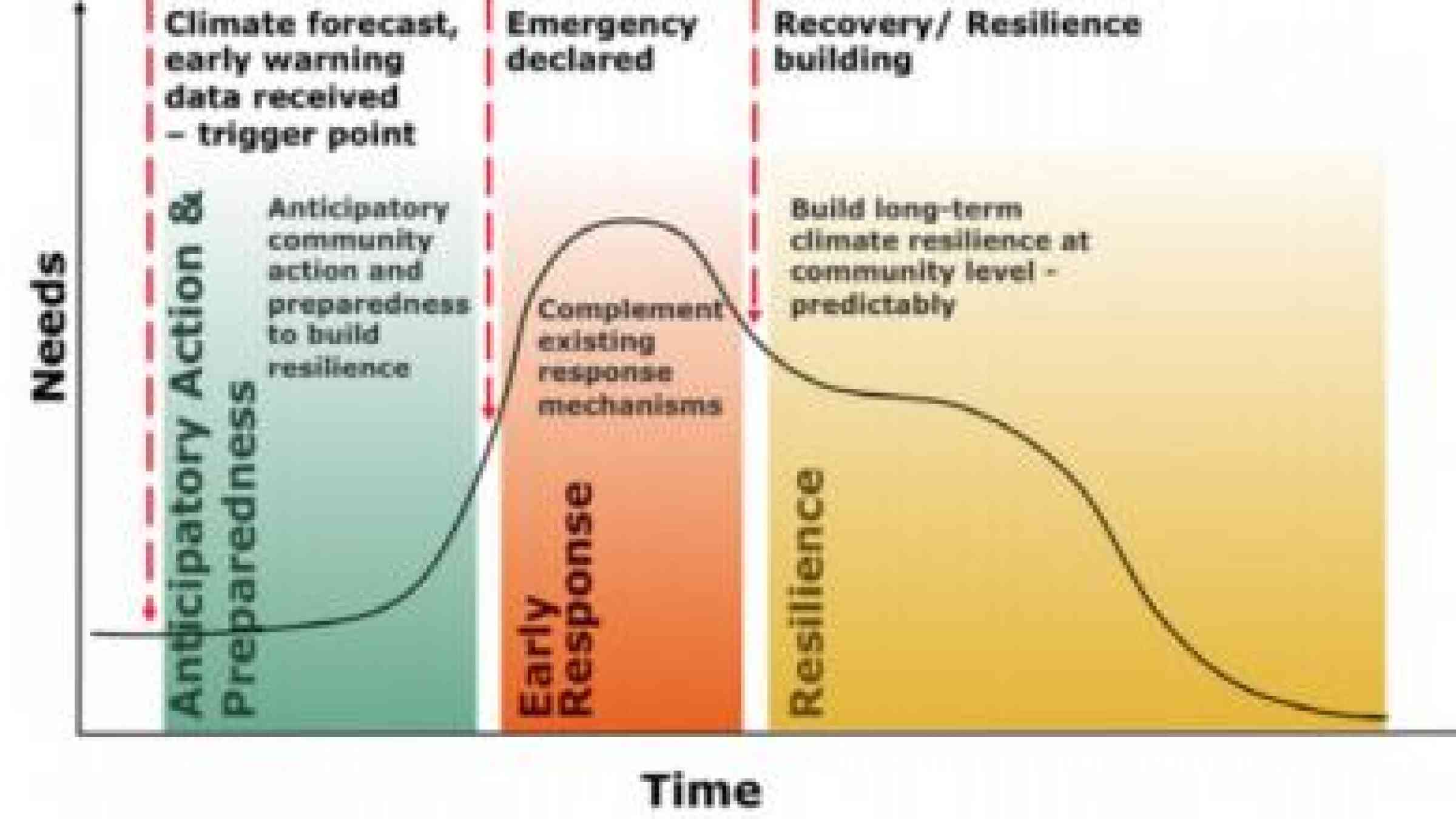WFP: Releasing disaster funds before crises would transform humanitarian response

Rome/Paris – As the world negotiates a new climate deal, the United Nations World Food Programme (WFP) and the International Federation of Red Cross and Red Crescent Societies (IFRC), together with German Red Cross (GRC), unveiled a forecast-based approach which would transform the humanitarian system. This new approach will release funds for disaster preparedness and response before the crisis occurs while providing the necessary funds for resilience building activities.
WFP’s Food Security Climate Resilience Facility (FoodSECuRE) will shift the humanitarian model from a reactive system to one that looks forward and saves more lives, time and money. Both FoodSECuRE and a Red Cross project in Uganda – one in a range of Red Cross-Red Crescent forecast-based financing pilot projects – have been activated in recent weeks to meet climate-related disasters, the dramatic predictions of El Niño and extreme weather.
An anticipatory response not only protects people’s lives: new WFP research shows it also saves money. A 2015 FoodSECuRE analysis in Sudan and Niger shows that using a forecast-based system would lower the cost of the humanitarian response by 50 percent.
FoodSECuRE unlocks funds before disasters, but also ensures that funds are available between cycles of disasters, because only through reliable, multi-year funding will vulnerable people build their resilience to the effects of climate change.
“The humanitarian system is increasingly stretched financially and operationally. More weather disasters require responses in more places and for longer periods. We need new approaches. Now we have the tools to respond before a disaster hits and between recurrent disasters – it’s the only way to help lift vulnerable people out of a cycle of chronic hunger and poverty, for good,” said WFP Executive Director Ertharin Cousin. “Turning the FoodSECuRE tool into a meaningful global facility will require mobilizing US$400 million.”
In Guatemala and Zimbabwe, funds have been released through FoodSECuRE in areas where drought risk is high due to El Niño. Farmers have been trained to grow drought-resistant crops and to change their agricultural practices to conserve both soil and water, so that even if the harvest is bad, people will still have food on the table.
Increasing climate disasters, humanitarian needs and short-term financing mechanisms mean that new approaches are urgently required. FoodSECuRE blends scientific forecasting mechanisms with flexible long-term financing that helps people build their resilience.
The Red Cross Red Crescent has seven operational pilot projects of this new approach around the world. “Using state-of-the-art weather and climate forecasts, we can trigger action to prepare for disaster,” says Garry Conille, Under Secretary General of the IFRC. “Now, what is needed is a comprehensive strategy to fund the development and operationalization of forecast-based finance systems at the national and international level.”
In Uganda, funds were released from a novel German Red Cross (GRC) preparedness fund to allow the Uganda Red Cross to distribute items based on a flood forecast. With a few days’ anticipation of rising water levels, Red Cross volunteers distributed water purification tablets and flood protection items to hundreds of vulnerable families. This is part of a project funded by the German Federal Ministry for Economic Cooperation and Development.
“Because of this El Niño that is battering this country, the Ugandan Government and the Uganda Red Cross were able to do some pre-emptive interventions in Uganda,” said Minister Musa Ecweru of Uganda at the Understanding Risk and Finance conference in Addis Ababa. “This is a real departure from our tradition of waiting until it arrives and then we act.”
The German Federal Foreign Office’s Action Plan on Climate, coordinated by the GRC, meanwhile, centres on forecast-based financing pilots by WFP or National Societies in Bangladesh, the Dominican Republic, Haiti, Mozambique, Nepal, Peru and the Philippines.
# # #
About the World Food Programme
WFP is the world's largest humanitarian agency fighting hunger worldwide, delivering food assistance in emergencies and working with communities to improve nutrition and build resilience. Each year, WFP assists some 80 million people in around 80 countries.
Follow WFP on Twitter @wfp_media and @wfp and @RChoularton
About the IFRC
The International Federation of Red Cross and Red Crescent Societies (IFRC) is the world’s largest volunteer-based humanitarian network, reaching 150 million people each year through its 189 member National Societies. Together, IFRC acts before, during and after disasters and health emergencies to meet the needs and improve the lives of vulnerable people. It does so with impartiality as to nationality, race, gender, religious beliefs, class and political opinions.
For more information, please visit www.ifrc.org. You can also connect with us on Facebook, Twitter, YouTube and Flickr.
About the German Red Cross
The German Red Cross is part of the International Red Cross and Red Crescent Movement, and contributes to humanitarian aid worldwide, both in acute emergencies and in long-term development cooperation, currently working in some 50 countries of Africa, Asia, the Americas, Europe and the Middle East.
For more information please contact:
WFP
(email address: firstname.lastname@wfp.org):
Fiona Guy, WFP/Rome, Paris, Tel. +39 06 6513 3187, Mob. +39 349 9208584
Frances Kennedy, WFP/Rome, Tel. +39 06 6513 3725, Mob. +39 346 7600806
Gregory Barrow, WFP/London, Tel +44 7508 868 997, Mob. +44 7968008474
Gerald Bourke, WFP/New York, Tel +1-646 556 6907, Mob. +1 646 525 9982
IFRC
Benoit Matsha-Carpentier, IFRC public communications team leader
(email: benoit.carpentier@ifrc.org) Tel: +41 79 213 24 13
German Red Cross
Alexandra Rüth, Coordination Climate Change Adaptation, German Red Cross, Berlin
(RuethA@drk.de ) Tel +49 30 85404-326; Follow GRC on twitter @AlexandraRuetha
